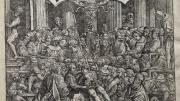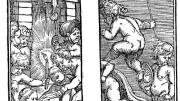The title page of Andreas Vesalius’s monumental 1543 anatomy textbook, De humani corporis fabrica (On the Fabric of the Human Body), depicts a public dissection. In an amphitheater, the famous anatomist describes features in a cadaver’s open abdomen as a crowd looks eagerly on. In Renaissance Padua, where Vesalius taught, public anatomies were an event. Two or three hundred spectators—physicians, medical students, municipal officials, visiting dignitaries, and ordinary citizens alike—flocked to watch.
But the celebrated public anatomy was not the only setting in which dissections took place, says Katharine Park, Zemurray Stone Radcliffe professor of the history of science. In a lecture Thursday night titled “Intimate Inquiries, Public Displays: Situating Anatomy in Renaissance Italy”—given to celebrate the opening of a special exhibit titled Body of Knowledge: A History of Anatomy (in Three Parts) at the Collection of Historical Scientific Instruments—she discussed the role of anatomy in Renaissance Italy and the various contexts in which dissections were performed.
The popularity of public anatomies made them poor settings for medical learning. Students were relegated to the “peanut gallery,” Park said, from which the intricacies of anatomy were not observable. The events had other pedagogical shortcomings as well. “The public dissection is a one-shot deal,” she explained. “It’s typically one body, and you have to show everything on that one body.” Certain muscles, for instance, were best shown after being steeped in water for several days—an impossibility in the rushed timeframe of a public anatomy. Moreover, the bodies themselves—the cadavers of executed criminals—did a poor job of showcasing the anatomical variations in age, sex, and state of health that physicians necessarily encounter.
In response, Park says, physicians and their students turned to “private anatomies”—a practice that, though poorly documented, she believes was widespread. Some dissections took place as part of autopsies, commissioned by families to understand hereditary illnesses. “The private anatomies were what students really liked,” says Park. In these smaller, informal settings, students could see the effects of illness, as well as discuss surgical methods and patient treatment.
Both public and private anatomies, and some of the latter’s illicit aspects, were memorialized in Vesalius’s book. At each chapter’s beginning, an historiated capital letter depicts anatomical practices, with cherubic putti as medical students. The letter “O” depicts the boiling of a skull to prepare the bones for examination; the letter “I” shows a grave robbery at night. Students’ less savory means of obtaining bodies for dissection—funeral hijackings are documented—caused significant tensions between university and municipal officials.
Eventually, Park said, universities regularized private dissections by including them as a more formal part of the medical curriculum, and they flourished alongside their public counterparts. “Public anatomies thrive because they’re very important for asserting the dignity of the university and the dignity of the state,” said Park. “The private anatomies thrive because they give students what they want.”
Visitors to the accompanying exhibit at the Collection of Historical Scientific Instruments can see books (including a copy of Vesalius’s masterpiece), instruments, and anatomical models (a 78-inch-tall skull and 48-in-long skeleton of a foot are on display) that showcase the social and cultural practices of anatomy through the centuries. The exhibit, which is located on the second floor of the Science Center, runs until December 5.
For more on the Collection of Historical Scientific Instruments, see “Telltale Apparatus.” The giant skull and foot models are described at greater length in “Skull Walking.”










